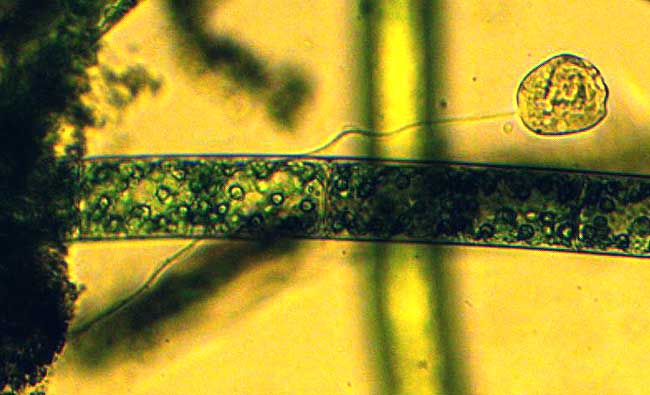Excerpts from Jim Conrad's
Naturalist Newsletter

from the January 13, 2013 Newsletter issued from the valley of the Dry Frio River in northern Uvalde County, southwestern Texas, on the southern border of the Edwards Plateau; elevation ~1750m (~5750 ft); N29.62°, W99.86°; USA
VORTICELLA
Though days are gradually lengthening and there's a decided feeling of springtime in the air, the landscape continues to be void of plants with flowers, and insects, while present, are few. One way I compensate is by taking field trips in drops of water from the little Dry Frio River behind the cabin. Beneath a microscope, a drop of river water is like a vast forest with diverse flora and fauna. Something new found this week is shown above.
The new discovery is the little, transparent, ball-shaped item at the end of the curvy, hairlike stem cutting diagonally across the image. The heavy, greenish, dark band horizontal in the picture's center is a strand of filamentous alga. The diameter of both the alga filament and the ball-like item is about 70 microns. The width of an average human hair is about 100 microns.
The ball-shaped thing caught my attention as it slowly moved across the field of vision, taking up slack in its slender, wavy stem. Once the stem was straight and taut, the ball remained in one place for a couple of seconds, then so suddenly that I didn't see it happen it disappeared, reappearing closer to where its stem apparently was attached, the stem itself once again looking curvy and loose. Then again the ball moved away from its stem base, maybe for fifteen or twenty seconds, until its stem was straight again, and then suddenly again the ball jerked back closer to the root, and again began its journey outward, this time in a slightly different direction.
Remembering this organism from biology class decades ago, I realized that the "ball" had an opening opposite its point of attachment with its stem, or peduncle. Tiny, hairlike cilia sweep food such as bacteria through the hole into the spherical body, where it's digested.
This is a Vorticella, described as being common and worldwide of distribution, found especially on leaves and roots of submerged vegetation, but also on shells of animals such as snails and turtles.
Though behaving like animals, usually Vorticellas are regarded as neither plants nor animals, but rather protozoans of the Kingdom Protista. However, as greater understanding of evolution develops, many say that the "kingdoms" of organisms (there's the Plant Kingdom, the Animal Kingdom, etc.) sometimes overlap -- and that the whole concept of "kingdom" is misleading -- so Vorticellas may be protozoans but also very primitive animals. Estimates of the number of species of the genus Vorticella vary from 15 or so to over a hundred, depending on your expert.
I'd known from school that Vorticellas exist, but only now am I realizing that they're part of my life here along the little Dry Frio River, and if you have standing, unpolluted water near you, they're probably in your life, too. They prey on bacteria and other tiny organisms and are preyed on themselves by tiny aquatic animals and by critters such as snails who graze the surfaces of aquatic plants.